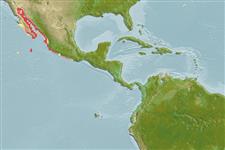Environment: milieu / climate zone / depth range / distribution range
Ecologia
marinhas associadas(os) a recifes; intervalo de profundidade 1 - 50 m (Ref. 5222). Tropical; 32°N - 18°N, 115°W - 102°W
Eastern Central Pacific: southwest coast of Baja California throughout the Gulf of California to Jalisco, Mexico.
Tamanho / Peso / Idade
Maturity: Lm ? range ? - ? cm
Max length : 86.0 cm TL macho/indeterminado; (Ref. 40637); peso máx. publicado: 9.6 kg (Ref. 40637)
Espinhos dorsais (total): 11; Raios dorsais (total): 16-18; Espinhos anais 3; Raios anais : 10 - 11. Distinguished by the following characteristics: greenish to greyish brown body color with small reddish brown spots and irregular pale spots and lines; fins with white margins; small portion of population exhibit xanthic pattern which is entirely bright yellow-orange, sometimes with few irregular black spots; depth of body contained 2.7-3.1 times in SL; head length 2.6-2.8 times in SL; angle of preopercle in adults with weakly-developed serrate lobe; posterior nostrils of large adults 2-3 times larger than anterior ones (Ref. 89707).
Prefers rocky areas in shallow water at depths of about 50 m. Adults feed on schools of the flatiron herring, Harengula thrissina, and anchoveta, Cetengraulis mysticetus when available; if not, on other schooling fishes or non-schooling fishes. Most feed at dawn and dusk, with a peak in activity about 20 minutes after sunset. Juveniles feed throughout the day on a variety of benthic fishes and crustaceans.
Ciclo de vida ou comportamento de acasalamento
Maturidade | Reprodução | Desova | Ovos | Fecundidade | Larvas
Heemstra, P.C. and J.E. Randall, 1993. FAO Species Catalogue. Vol. 16. Groupers of the world (family Serranidae, subfamily Epinephelinae). An annotated and illustrated catalogue of the grouper, rockcod, hind, coral grouper and lyretail species known to date. Rome: FAO. FAO Fish. Synop. 125(16):382 p. (Ref. 5222)
Status na Lista Vermelha da UICN (Ref. 130435)
Ameaça para os humanos
Harmless
Uso pelos humanos
Pescarias: pouco comercial
Mais informação
ReferênciasAquaculturaPerfil para aquaculturaEstirpesGenéticaElectrophoresesHereditariedadeDoençasProcessamentoNutrientsConversão de massa
ColaboradoresFotosStamps, Coins Misc.SonsCiguateraVelocidadeTipo de nataçãoÁrea branquialOtólitosCérebrosVisão
Ferramentas
Relatórios especiais
Baixar XML
Fontes da internet
Estimates based on models
Preferred temperature (Ref.
123201): 20.6 - 26.8, mean 22.4 °C (based on 24 cells).
Índice de diversidade filogenética (Ref.
82804): PD
50 = 0.5000 [Uniqueness, from 0.5 = low to 2.0 = high].
Bayesian length-weight: a=0.00933 (0.00429 - 0.02028), b=3.04 (2.87 - 3.21), in cm total length, based on LWR estimates for this Genus-body shape (Ref.
93245).
Nível Trófico (Ref.
69278): 4.5 ±0.80 se; based on food items.
Generation time: 11.9 ( na - na) years. Estimated as median ln(3)/K based on 1
growth studies.
Resiliência (Ref.
120179): Baixo, tempo mínimo de duplicação da população 4,5 - 14 anos (K=0.09).
Fishing Vulnerability (Ref.
59153): High to very high vulnerability (67 of 100).
Nutrients (Ref.
124155): Calcium = 22.1 [13.6, 39.6] mg/100g; Iron = 0.449 [0.244, 0.783] mg/100g; Protein = 18.6 [16.8, 20.3] %; Omega3 = 0.131 [0.083, 0.208] g/100g; Selenium = 35.6 [18.8, 68.7] μg/100g; VitaminA = 137 [45, 467] μg/100g; Zinc = 0.808 [0.556, 1.143] mg/100g (wet weight);
